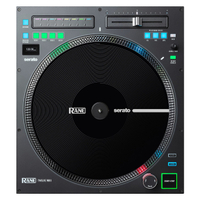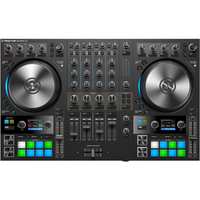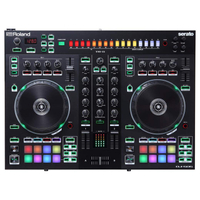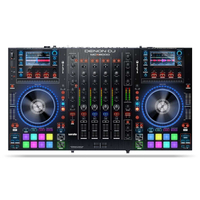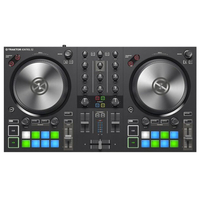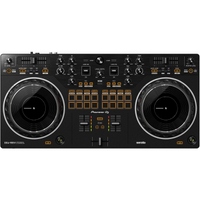Best DJ controllers 2024: Hands-on control for Serato, rekordbox, Traktor and more - our expert picks
Hardware DJ devices for PC, Mac and iOS, tested by our experts

While there are still plenty of traditionalists keeping the vinyl dream alive, and even a few cassette DJs too, these days most DJs opt for some kind of digital option. This might mean using a standalone player device, a laptop and controller combo, or simply a pair of USBs, and within these options, there is a huge variety of levels and options. In this guide to the best DJ controllers, we’ve covered the latest and greatest in 2024, for every budget and every type of DJ.
The DJ controller market currently ranges from fun little units with built-in ‘light shows’ that are definitely meant only for home use, a vast range of low to mid-range controllers with a baffling mix of specifications, battle decks for turntablists and scratch DJs, right up to complex rigs that emulate the functionality of top-end club setups. All controllers run on software, and some are compatible with several of the main DJ software (rekordbox, Traktor, Serato, and Virtual DJ), others only one or two. Then there are some controllers you can use with desktop machines, others that you can use with your mobile device.
And somewhere within all this gear is the perfect controller for your needs. Whether you want to replicate the feel of traditional turntables, mixers, and CDJs, or you need a modern pad device designed for sample triggering and effects manipulation, our advice on the best DJ controllers in this guide will help you make the perfect choice for your DJing style, requirements, preferred software and budget.
With the development of standalone ‘players’ that can control DJ software, the definition of ‘DJ controller’ is broadening, but for this feature we’re focusing only on units specifically designed as controllers for DJs.
Quick list
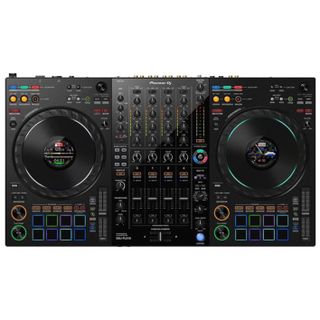
The FLX10 is Pioneer’s mastery flagship controller. There are several eye-catching features including enlarged and improved jog-wheel displays and a DMX output enabling it to connect directly to a lighting rig for control via rekordbox’s Lighting function.
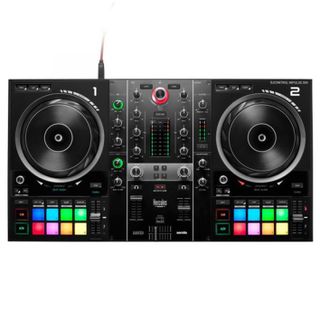
Competitively priced and with substantial functionality at this price point, the Hercules Inpulse 500 two-channel Serato controller is affordable, ideal for home use, and able to handle small public gigs too.
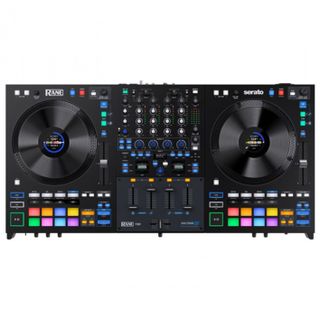
Rane’s Four is one of the best when it comes to stem separation. With dedicated Stem Split buttons and control over Stem FX, the Four offers easy, hands-on control over Serato’s latest and most creative features.
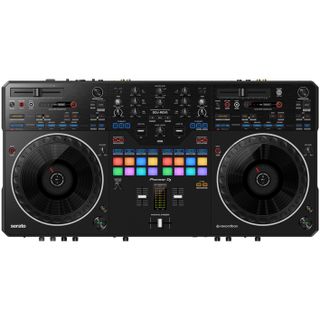
This battle-style controller for Serato DJ and rekordbox has a design and layout aimed primarily at scratch DJs. This means more emphasis on performance features like large, robust jog wheels, chunky pads for cue jumping and quality Magvel crossfader.
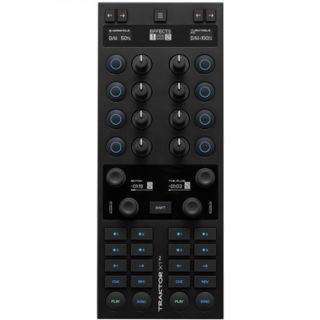
One of NI’s most compact DJ controllers is targeted primarily at using Traktor’s looping and effect sections, with buttons and rotaries to aid quick loop adjustment and on-the-fly effects tricks. The new Mixer mode means effect controls can also be used to alter track levels and EQs.
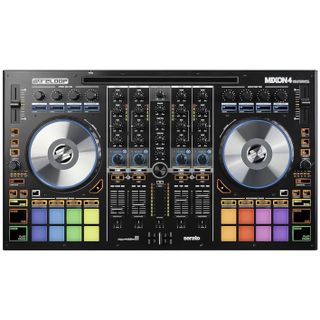
Designed for both Serato Pro DJ and Algoriddim djay PRO, the Mixon 4 is capable of mixing on PC, Mac, iOS and Android. The controller includes four deck control, a four channel audio interface, 16 performance pads and a docking station that can hold a 12.9” iPad Pro.
Best overall
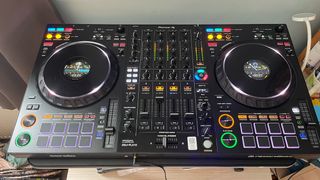
Specifications
Reasons to buy
Reasons to avoid
The FLX10 is Pioneer’s mastery flagship controller, replacing the DDJ-1000 and 100SRT at the top of the company’s range. Pioneer calls this a multi-application controller, as it’s designed for plug-and-play use with both rekordbox and Serato, and unlocks paid features in both software applications. Arguably though, integration is slightly tighter with rekordbox than it is with Serato.
There are several eye-catching features here that set the FLX10 apart from its predecessors. The most visually obvious things are the enlarged and improved jog-wheel displays, capable of showing detailed waveforms, deck info, track artwork or your own DJ logo. The controller also adds a DMX output on the rear, allowing it to connect directly to a lighting rig for control via rekordbox’s Lighting function (a paid extra).
The controller’s layout has been reworked to take advantage of the stem separation tech recently added to rekordbox. This allows for stem elements of tracks to be mixed and have effects applied separately.
While there are elements of Pioneer’s design that divide opinion - such as the sound of the filters and effects - they inarguably offer some of the slickest and tightest control designs going. For rekordbox users in particular, we think the FLX10 offers an unrivalled control experience with some nicely future-proofed features.
Read our full Pioneer DJ DDJ-FLX10 review
Best on a budget
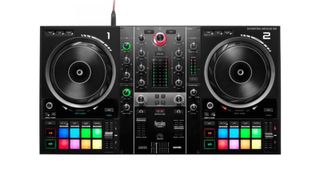
2. Hercules DJControl Inpulse 500
Our expert review:
Specifications
Reasons to buy
Reasons to avoid
The Hercules DJControl Inpulse 500 is a well-equipped budget DJ controller option that comes with the basic functionality required to learn DJing and to handle small public gigs too.
Of particular interest is a separate additional channel strip for an aux input - which could be a drum machine, music player or smartphone - and you can also connect a mic to the balanced input which has low and high EQ. The retractable feet and metal plate on the mixer are also nice touches for a budget machine.
The positioning of the jog wheel, pitch control and cue buttons echo the Pioneer industry standard, so transferring your mixing skills from the Inpulse to a pro club set-up should be fairly straightforward. While it lacks the detailed functionality of higher-end units, it’s still a great DJ controller for beginners and would function well as a working DJ’s home set-up.
Best for stem separation
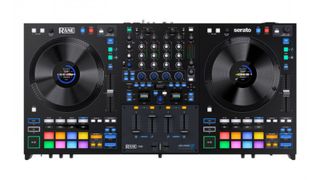
3. Rane Four
Our expert review:
Specifications
Reasons to buy
Reasons to avoid
Stem separation is currently the hot new feature among DJ applications. The likes of Serato and rekordbox recently adopted the tech, which allows for tracks to be stripped down to their constituent parts so that drums, vocals, bass, etc can be mixed individually. Fittingly, a lot of new DJ controllers are designed to make use of these features, and Rane’s Four is one of the best of them. With dedicated Stem Split buttons and control over Stem FX, the Four offers easy, hands-on control over Serato’s latest and most creative features.
Stem separation is not the only trick in the Rane Four’s arsenal though. For a relatively modest-sized controller, the Four is absolutely crammed with features, including control over mixer parameters, effects, cues, samples and more. Build quality is impressive too, with sturdy controls and a quality Mag Four crossfader.
As its name suggests, the two jogwheels allow for control over up-to four virtual decks, but the Four is also nicely expandable, with ins-and-outs that allow the user to connect analogue inputs such as turntables, or additional controllers such as the Rane Twelve.
Best mid-level scratch controller
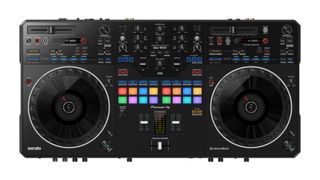
4. Pioneer DJ DDJ-REV5
Our expert review:
Specifications
Reasons to buy
Reasons to avoid
The latest addition to Pioneer’s scratch-focused REV range, the REV5 is a significantly more ‘pro’ featured controller than the entry-level REV1, albeit with a sub-$/£1k price that makes it far more reasonable for home users than the top-end REV7.
As with other entries in the range, the REV5 is a 2-channel, battle-style controller for Serato DJ and rekordbox, with a design and layout aimed primarily at scratch rather than club or event DJs. This means far more emphasis on performance features like large, robust jog wheels, chunky pads for cue jumping and sample triggering, and quality Magvel crossfader.
Unlike older controllers, the REV5 also has front panel controls designed specifically to make use of the stem separation capabilities of rekordbox and Serato, which let the user mix and apply effects to individual track elements such as just vocals, drum parts or bass. Other interesting new features include the ability to play the performance pads like a piano keyboard, for adding a melodic flourish to your sets.
Use of the REV5 unlocks mixing features in rekordbox without the need for a subscription, and includes a voucher for Serato’s (somewhat essential) Pitch and Time expansion.
Best Traktor controller
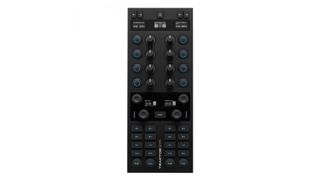
Specifications
Reasons to buy
Reasons to avoid
Traktor users have been facing something of a drought when it comes to new DJ hardware. It’s been five years since NI released the S4 Mk3 and, aside from a few special edition reskins, we’ve not seen any new Traktor hardware since.
In that time Native Instruments changed ownership and merged with other music technology brands iZotope and Plugin Alliance, and the lack of new hardware led some to speculate that the merger had resulted in the company largely giving up on its DJ products. Thankfully, with the recent release of the new third generation X1, NI has turned its attention back on to Traktor.
The X1 is one of NI’s most compact DJ controllers. Unlike the likes of the S2 and S4, which offer full control over decks and mixer functions, the X1 is targeted primarily at using Traktor’s looping and effect sections, with buttons and rotaries to aid quick loop adjustment and on-the-fly effects tricks. However, this third gen version also adds a new Mixer mode, whereby the effect controls can be used to alter track levels and EQs. Its controls can also be custom mapped in Traktor Pro to suit your specific DJing style.
Other new features include a new customisable lighting feature that can be assigned to do things like warn the user when a track or loop is approaching its end point. The X1 has also added three USB ports to the rear, making it easy to chain the device with other Traktor controllers for a more comprehensive setup.
Best iOS/Android
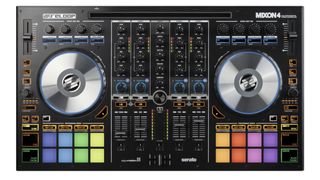
6. Reloop Mixon 4
Our expert review:
Specifications
Reasons to buy
Reasons to avoid
The Mixon 4 from Reloop is the company’s flagship hybrid-controller and the only kind of its type in this best DJ controllers guide. Designed for both Serato Pro DJ and Algoriddim djay PRO, the Mixon 4 is capable of mixing on PC, Mac, iOS and Android.
Plus, there’s also Spotify integration within djay 2 software, which will require a premium subscription. The controller includes four deck control, a four channel audio interface, 16 performance pads and a docking station that can hold a 12.9” iPad Pro.
More options...
Looking for something else? Here are more options that we recommend based on our testing.
Rane Twelve MkII |Connectivity: USB | Channels: n/a | Deck control: 4 (from one shared platter) | Software: Plug and play with Serato DJ Pro (no license included)
Rather than replicate a full DJ setup, with two or more players and a mixer, this controller is designed specifically to replace a single vinyl turntable. While most DJ controller jog wheels tend to feel – at best – similar to a club-standard CDJ, with its aluminium platter and “true vinyl-style” drive the Rane Twelve is as close as you can get to mixing with wax without using the real thing.
MusicRadar score: 4.5/5
Native Instruments Traktor Kontrol S4 Mk3 | Connectivity: USB 2.0 | Channels: 4 | Deck control: 4 | Software: Traktor Pro 3 (full license included)
The third generation update to NI’s four deck Traktor controller is a significant one. The main elements to receive an overhaul here are the jog wheels; these are now motorised and make use of the company’s new ‘haptic’ technology that offers tactile feedback of cue points and more. The design as a whole has been shaken up too though. For one thing, the pitch faders have been moved to a CDJ-style ‘both on the same side’ correlation, as opposed to sitting along the outside edges, as on the Mk2. There’s a new Mixer FX section too, as well as small displays sitting below each jog wheel.
MusicRadar score: 5/5
Read our full Native Instruments Traktor Kontrol S4 Mk3 review
Roland DJ-505 | Connectivity: USB 2.0 x1 | Channels: 2 | Deck control: 4 | Software: Serato DJ Pro (full license included)
The real selling point here is the inclusion of the ‘TR-S’ drum machine, and the DJ-505 delivers well in this regard. The sounds are the same as those in the first gen TR-8, offering digital recreations of Roland’s 909, 808 and 707 beatmakers - some of the best emulations you’ll find in modern hardware. The 505 isn’t the top of Roland’s controller range, but we like the affordability and convenience of this model.
MusicRadar score: 4/5
Read our full Roland DJ-505 review
Denon MCX8000 | Connectivity: 2x USB 2.0 | Channels: 4 | Deck control: 4 | Digital connectivity: Stage LinQ
The MCX8000 from Denon DJ is the company’s flagship controller, which it proudly states is "the first true DJ hardware/software controller". Bold words, but then the specs on the 8000 are pretty impressive. Not only can this 4-deck device be used to control Serato DJ on your computer, but thanks to the inclusion of the Denon DJ Engine software, it can also operate completely standalone. Comparatively cheaper than other standalone controllers from leading manufacturers, the MCX8000 also includes a Stage LinQ network connection to control lighting and video.
MusicRadar score: 4/5
Native Instruments Traktor Kontrol S2 Mk3 | Connectivity: USB/iOS | Channels: 2 | Deck control: 2 | Software: Traktor Pro 3 (full license included included), Traktor DJ
The latest iteration of NI’s entry-level Traktor controller is a great tool for new DJs. It can connect to both a laptop running Traktor Pro 3 or NI’s free Traktor DJ iOS app, with no need for an additional cable or adapter. This controller is very easy to use and, although its jog wheels lack the finesse of its bigger siblings, has everything needed to get started and play small parties or home DJ sets.
MusicRadar score: 4/5
Read our full Native Instruments Traktor Kontrol S2 Mk3 review
Pioneer DJ REV-1 | Connectivity: USB | Channels: 2 | Deck control: 4 | Software: Serato DJ Lite (Free download)
The REV-1 is a two-channel controller in battle configuration, meaning the pitch faders are placed above, rather than beside the jog wheels. While the REV-1 is relatively compact, it boasts larger than average jog wheels - which is one of the main areas where budget controllers tend to let scratch DJs down. The mixer section is roughly based on Pioneer’s DJM-S range of battle mixers, although it’s slightly more cramped and less stylish looking. That said though, the REV-1 is well equipped with performance pads and a mic input.
MusicRadar score: 4/5
Buying advice

How to choose the best DJ controller for you
MusicRadar's got your back
There are several things to consider when shopping for a DJ controller. The first, and possibly biggest consideration is your choice of DJ software. If you favour Serato DJ, it’s important to note that the software is only compatible with certain controllers, built-in collaboration with Serato - a full list of which can be found over at their site.
In fact, the majority of DJ controllers will be designed with one or two specific bits of software in mind, and many come with a certain application included in the price - so your choice of controller is likely to be very much influenced by your DJ app preference, or vice versa.
It’s also worth considering whether you’ll need any audio inputs built in - i.e, the capability to connect turntables, CDJs or an instrument to your setup - and if you might want to expand with timecoded vinyl or CDs in the future. Some controllers included in this guide also work as a standalone DJ mixer, without the need to connect to a computer, which could be another consideration.
Then there’s sound quality, size, looks, build quality, price... the list goes on. In short, it’s difficult to crown any one bit of kit the absolute ‘best’ controller, but what we can do is present you with a round-up of our favourites among the options currently available.
What do I need to know about stem separation technology?
The latest trend in DJ applications is the implementation of stem separation, which uses AI to separate tracks down to the constituent parts - typically vocals, drums, bass and synths - in real time. Many newer controllers, released in 2023 or later, will have dedicated hands-on control of these features. Older controllers may still allow you to control stems, but won’t have been designed with these capabilities in mind.
Which brands, applications and software should I consider?
As the result of some recent acquisitions, a significant amount of the major DJ brands are now owned by one of two parent companies. The first of these is AlphaTheta, the parent company of Pioneer DJ and, as of 2023, also owner of DJ software brand Serato. With that acquisition, AlphaTheta now owns two of the most notable DJ applications, Serato DJ and Pioneer’s rekordbox DJ.
On the other side is InMusic, parent company of Denon DJ, Numark, Stanton and Rane (as well as several other non-DJ brands including Akai). InMusic brands all make controllers designed to work with multiple DJ applications, including Serato, and there’s no indication that AlphaTheta’s acquisition of the software will change that. Denon DJ does have its own software application, Engine DJ, although this is primarily a librarian application and OS for the company’s standalone DJ systems, rather than a direct rival to the likes of Serato.
A third significant brand worth mentioning is Native Instruments, creators of Traktor. Unlike Pioneer or Denon, NI doesn’t make hardware for use with DJ applications other than its own - its only hardware devices, the Traktor Kontrol range, are only configured for use with Traktor Pro or Traktor DJ.
Native Instruments is now part of the Soundwide group, alongside music technology brands Plugin Alliance and iZotope. Recent years have seen very few significant new Traktor hardware products or major software updates, leading to some speculation that the company had lost enthusiasm for its DJ business. As of late 2023, however, NI has started to release updates to some of its hardware controller lines, including an overhaul to its Traktor X1 device.
What do all the mergers and acquisitions mean for users? As of right now, very little. InMusic gear can still be used with Serato, and we can’t imagine that will change in the future. What is more likely is that Pioneer DJ gear will increasingly offer plug-and-play capabilities with both rekordbox and Serato (as is already true of the flagship FLX10, although rekordbox users are slightly better served).
How we choose the best DJ controllers
There’s only really one sensible way to test a DJ controller, and that’s to get hands-on and mix with it. That’s exactly what our team of reviewers do whenever trying out a new DJ device.
However, we’re aware that not all DJs perform in the same way, so we do our best to get into the mindset of as many different styles of DJ as possible to investigate how each might get on with any particular controller. We ask how each feels for long, slow mixes, how the crossfader and jogwheels feel for quick cuts and performance, how any pads, EQs or effects controls respond in a performance setting.
A key factor too, as with any musical controller, is how well the device interacts with its intended software. Does it feel tight and responsive? Do the controls offer easy access to all the most important elements of the application? A good controller should keep you away from the mouse and screen and let you feel connected to your music. That’s exactly what we’re looking for when we’re testing a new DJ controller.
Read more about how we test music making gear and services at MusicRadar.
Related buyer's guides
- Our pick of the best DJ headphones available today
- Upgrade your rig with the best DJ speakers
- The best DJ turntables: top decks for vinyl DJs
- How to DJ on a laptop: a beginner's guide
- Check out the best beginner DJ mixers
- Essential DJ accessories for the studio to the booth
- Our pick of the best gifts for DJs
Get the MusicRadar Newsletter
Want all the hottest music and gear news, reviews, deals, features and more, direct to your inbox? Sign up here.
I'm Editor-in-Chief of Music Technology, working with Future Music, Computer Music, Electronic Musician and MusicRadar. I've been messing around with music tech in various forms for over two decades. I've also spent the last 10 years forgetting how to play guitar. Find me in the chillout room at raves complaining that it's past my bedtime.

“We were blown away by the level of risk-taking”: The UK’s female, non-binary and trans music tech community is hailed as “thriving”

“A dream come true, I’ll never forget it”: Jay Weinberg guests with King Gizzard and the Lizard Wizard

“Music and guitar playing comes from within and it’s to be enjoyed at any level”: Yngwie Malmsteen has a very important message for anyone who plays the guitar
